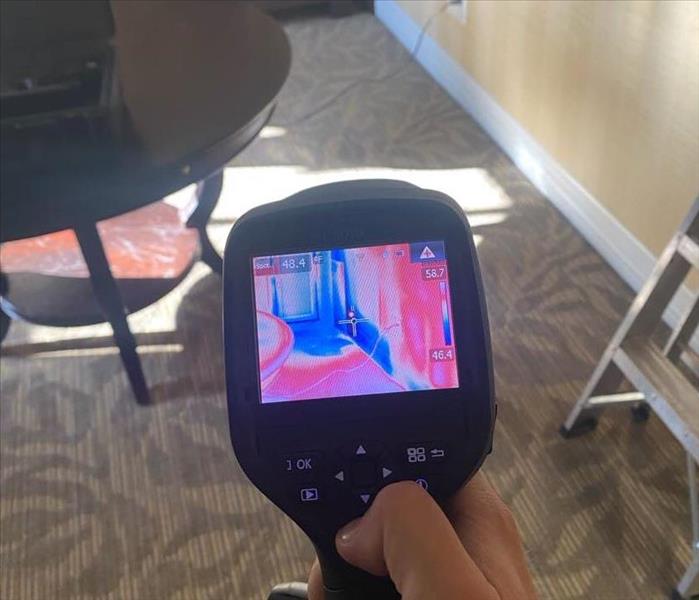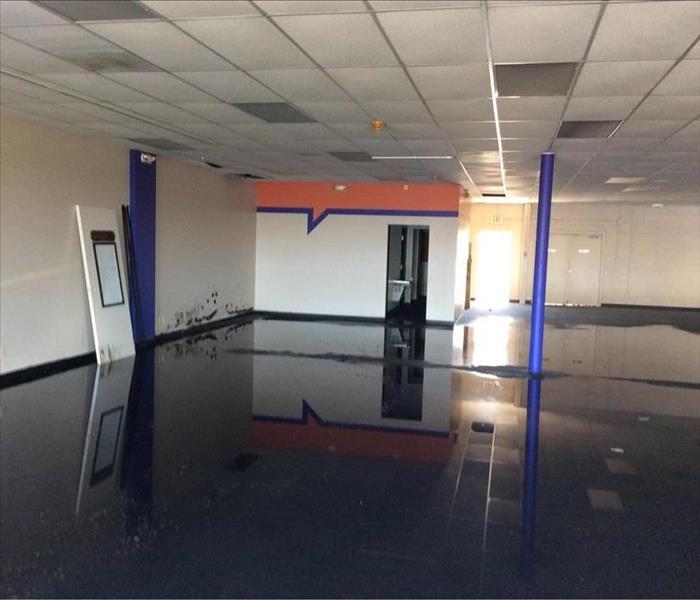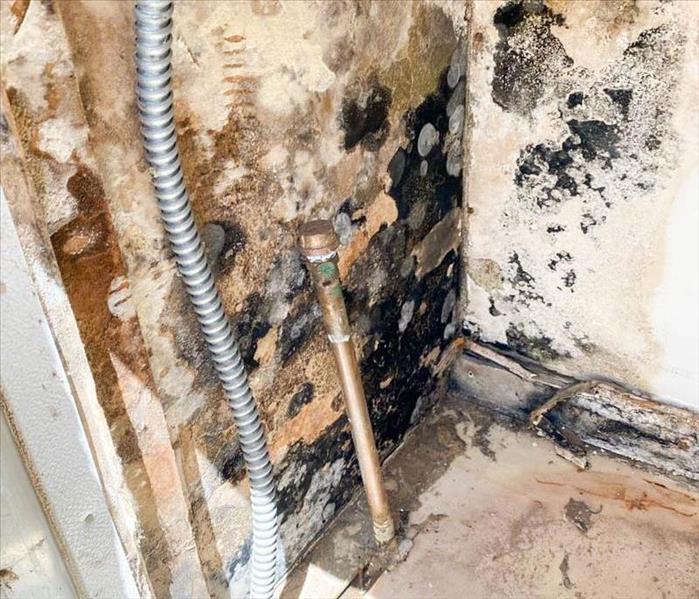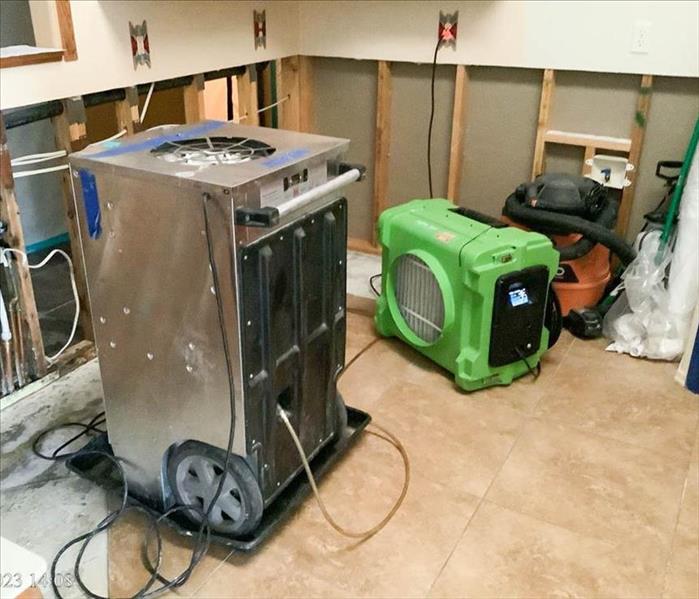Recent Posts
Protecting Your Home & Health: Mold Prevention and Restoration
3/26/2025 (Permalink)
We know mold concerns can be unsettling, affecting your comfort, health, and peace of mind. Preventing mold growth is essential to maintaining a safe, healthy home environment.
Routine checks for moisture issues can make a significant difference. Inspect common problem areas such as laundry rooms, under sinks, near windows, and around air conditioners. Using exhaust fans during showers and cooking, quickly repairing leaks, and maintaining appropriate indoor humidity levels are simple yet effective strategies to keep mold away.
However, if mold is already a problem, addressing it quickly is crucial. SERVPRO of Northwest Phoenix/Anthem provides professional mold restoration with genuine care and understanding. Our trained specialists utilize safe, effective mold remediation techniques to fully restore your home. We understand your concerns and ensure the restoration process causes minimal disruption to your daily life.
Trust us to handle your mold concerns professionally and empathetically. SERVPRO of Northwest Phoenix/Anthem is committed to helping you reclaim your home, restoring your comfort, and protecting your family's health from mold issues.
Contact us (623) 780-9111
Restoring Homes After Winter Storm Damage in Northwest Phoenix/Anthem
1/28/2025 (Permalink)
Winter storms can create unexpected challenges for homeowners in Northwest Phoenix and Anthem. While Arizona isn’t known for harsh winters, occasional cold snaps and storms can lead to damage that requires immediate attention. From frozen pipes to wind-damaged roofs, winter weather can disrupt the comfort and safety of your home.
When pipes freeze due to dropping temperatures, they often burst, leading to water damage in walls, ceilings, and floors. Prompt action is necessary to mitigate the effects and prevent secondary issues like mold growth. High winds during winter storms can also loosen shingles, damage siding, or topple trees, causing structural problems that need expert care.
Professional restoration services are equipped to handle these challenges efficiently. Restoration teams are trained to address water intrusion, structural repairs, and drying processes, ensuring your home is safe and habitable. Advanced tools, such as dehumidifiers and air movers, help dry affected areas and prevent long-term damage.
Preparing your home for winter storms is important. Insulating pipes, maintaining gutters, and trimming overhanging tree branches can reduce the risk of damage. However, if your property is affected by unexpected winter weather, restoration professionals are ready to assist with quick, efficient solutions.
Don’t let winter storm damage disrupt your life. Professional teams specialize in restoring properties to their pre-damage condition, giving you peace of mind when you need it most.
Reach out (623) 780-9111 today for expert winter storm restoration services to protect and restore your home.
Stay safe and protect your home during dust storm season
7/25/2024 (Permalink)
Dust storms, or haboobs, are a common occurrence in Northwest Phoenix and Anthem. Here are some tips to prepare your home for dust storm season:
Seal Doors and Windows: Ensure that all doors and windows are properly sealed to prevent dust from entering your home.
Maintain Your HVAC System: Clean or replace air filters regularly to keep indoor air clean.
Create a Dust Storm Kit: Include items like masks, goggles, and a first-aid kit to protect yourself during a storm.
Secure Outdoor Items: Bring in or secure outdoor furniture, decorations, and trash cans to prevent them from being blown away.
Stay Informed: Monitor local weather forecasts and be prepared to take action if a dust storm is approaching.
By taking these precautions, you can protect your home and family during dust storm season.
Mold in Carpets: How to Remove and Prevent It
3/13/2024 (Permalink)
 Mold found in carpets can result in unpleasant odors and discoloration. In this blog, we will explore tips and steps for removing and preventing mold.
Mold found in carpets can result in unpleasant odors and discoloration. In this blog, we will explore tips and steps for removing and preventing mold.
Carpets are an attractive and comfortable flooring option, but they can also be susceptible to mold growth. Mold damage to carpets can occur due to various reasons, such as exposure to moisture, spills, and leaks. Mold found in carpets can result in unpleasant odors, discoloration, and even damage to the fibers. In this blog, we will explore tips and steps for removing and preventing mold in carpets.
Identifying the Mold in Carpets
Mold damage to carpets can be hard to detect, especially in the early stages. Some signs of mold in carpets include:
- Musty odors
- Discoloration of the carpet fibers
- Stains or discoloration on the carpet backing
- Water damage or stains on the walls or ceiling near the carpet
- The presence of mold or moisture elsewhere in the room or home
Steps for Removing Mold from Carpets
If you suspect mold damage in your carpets, it is crucial to address it promptly to prevent further contamination. Here are the recommended steps for removing mold from carpets:
- Personal Protective Equipment: Wear proper personal protective equipment, such as gloves and a respirator, during the mold remediation process.
- Isolation of the Affected Area: Isolate the affected area to prevent the spread of mold spores. Close off the area to other parts of the house and use plastic sheeting to create a barrier.
- Remove Any Excess Water: Dry the carpet as quickly as possible to prevent further mold growth. Remove any excess water using a wet/dry vacuum or absorbent towels.
- Apply Mold Cleaning Agent: Apply a mold cleaning agent to the carpet using a spray bottle or fogging machine. Allow the cleaning agent to sit for the recommended amount of time.
- Clean the Carpet: Clean the carpet thoroughly using a hot water extractor or steam cleaner. Ensure that all cleaning solution and moisture have been extracted from the carpet.
- Dispose of Any Contaminated Items: If any items, such as padding or carpeting, are too contaminated or damaged to be salvaged, dispose of them properly.
Tips for Preventing Mold in Carpets
Prevention is key to avoiding mold damage to carpets. Here are some tips to prevent mold growth in your carpets:
- Address Water Damage Promptly: If any water damage occurs, address it promptly to prevent excess moisture buildup and mold growth.
- Maintain Proper Ventilation in Your Home: Proper ventilation helps with moisture control, reducing the risk of mold growth.
- Use a Dehumidifier: Use a dehumidifier to reduce excess moisture in the air and maintain an optimal humidity level of around 50 percent.
- Clean and Dry Spills Promptly: Clean up any spills promptly to prevent them from seeping into the carpet fibers and creating a moisture source for mold growth.
- Regularly Clean Your Carpets: Regular carpet cleaning helps remove any dirt and moisture that can contribute to mold growth and prolongs the life of your carpet.
- Have Your Carpets Inspected and Cleaned Professionally: Regular professional inspection and cleaning help identify any potential mold issues and address them promptly before they escalate.
Mold damage in carpets can be unpleasant and harmful if left unaddressed. Identifying the mold, prompt removal, and prevention are crucial steps to keeping your carpets clean and mold-free. Follow the tips and recommendations provided above to remove mold damage from carpets and prevent future contamination. Consider seeking the services of a professional mold remediation team if the mold damage is extensive or if you are unsure of how to handle the remediation process. By taking these steps, you can ensure a mold-free and healthy living environment.
Restoring Landscaping After Water Damage to Your Lawn & Garden
2/14/2024 (Permalink)
Water damage doesn't just affect the interiors of our homes; it can also leave a lasting impact on the outdoor oasis we've cultivated. When floods or excessive water wreak havoc on our lawns, gardens, and soil, restoring the natural beauty of our landscape becomes a crucial part of the recovery process. In this blog, we'll explore the steps and tips for rejuvenating your outdoor haven after water damage.
Assess the Damage
Before diving into restoration, assess the extent of the damage to your landscaping. Identify areas of erosion, soil displacement, and the condition of plants. This evaluation will guide your restoration plan.
Remove any debris, silt, or mud deposited by the water. This may involve raking, shoveling, or using a wheelbarrow to clear away the remnants of the flood. Clearing debris helps create a clean slate for the restoration process.
Aerate Compacted Soil
Water damage can lead to soil compaction, limiting the flow of air, water, and nutrients to plant roots. Use aeration tools to loosen compacted soil, promoting better drainage and root development.
If water has caused uneven terrain or altered the grading of your landscape, regrade the affected areas. This helps prevent future water pooling and ensures proper water flow away from structures.
Inspect and Trim Damaged Plants
Inspect the condition of your plants. Trim damaged or dead branches to encourage new growth. Prune shrubs and trees strategically to maintain a balanced and healthy landscape.
In cases where plants are severely damaged or beyond recovery, consider replacing them. Choose resilient, water-resistant species that are well-suited to your climate and soil conditions.
Restore Soil Fertility
Floodwaters can wash away essential nutrients from the soil. Restore fertility by adding organic matter such as compost or well-rotted manure. This replenishes nutrients and supports healthy plant growth.
For areas with bare soil, reseed or replant to reintroduce greenery. Choose grass or plants that thrive in your region and match the specific conditions of your landscape.
Implement Erosion Control Measures
To prevent further soil erosion, implement erosion control measures. Mulch, ground cover plants, and retaining walls can help stabilize the soil and protect against future water damage.
Address drainage issues by installing proper drainage systems. French drains, swales, and other drainage solutions can redirect water away from vulnerable areas, preventing waterlogging. Regularly monitor your irrigation system to ensure it aligns with the current needs of your landscape. Adjust watering schedules based on weather conditions and the recovery stage of your plants.
Apply Grass Seed and Fertilizer
If your lawn has suffered significant damage, consider overseeding with grass seed and applying a balanced fertilizer. This promotes a lush, healthy lawn and helps cover bare patches.
If your garden is prone to flooding, consider creating raised garden beds. This elevated design helps prevent waterlogging and provides better control over soil conditions.
Introduce Native Plants
Native plants are well-adapted to local conditions and often require less maintenance. Introduce native species to enhance the resilience of your landscape against future water-related challenges.
Restoring your landscaping after water damage is not just about bringing back the greenery; it's about nurturing a living, breathing outdoor space that reflects the resilience of nature. By following these steps and tips, you'll not only revive your lawn, garden, and soil but also create an environment that blooms back to life, standing as a testament to the regenerative power of nature.
9 Ways to Protect Your Home During the Monsoons
1/17/2024 (Permalink)
 However, if the monsoon season does take a toll on your property, SERVPRO® of Northwest Phoenix/Anthem is here to assist.
However, if the monsoon season does take a toll on your property, SERVPRO® of Northwest Phoenix/Anthem is here to assist.
As the dark clouds of monsoon roll in, they bring not just torrential rain, but also the potential for severe damage to your property. At SERVPRO® of Northwest Phoenix/Anthem, we understand the importance of being prepared for these seasonal storms. We've compiled a 9-point checklist to help you weatherproof your home and avoid water damage during monsoons effectively.
1. Check Your Roof
Inspect your roof for signs of wear or damage, which can lead to leaks during heavy monsoon rains. Pay particular attention to worn-out shingles or tiles, and get any damages repaired by professionals.
2. Clean the Gutters and Downspouts
Blocked gutters and downspouts can cause water to overflow, leading to structural damage. Clean them thoroughly and ensure they are functionally guiding water away from your home’s foundation.
3. Inspect Window and Door Seals
While rain is lashing against your windows and doors, faulty seals can easily allow water into your home. Re-caulk windows and doors as necessary to ensure a waterproof seal.
4. Install Surge Protectors
Monsoons come with the risk of lightning and power surges. Protect your electrical appliances by installing surge protectors.
5. Protect Your HVAC Systems
Ensure your HVAC system, which includes your Air Conditioning units, have been checked and serviced. Cover outdoor units during surges of heavy rain to avoid damages.
6. Trim Overgrown Trees and Branches
Loose branches and weak trees can easily fall during heavy downpours and winds, posing a threat to your home. Trim back branches close to your home and consider removing any unstable trees.
7. Secure Outdoor Items
Secure or store away outdoor furniture, gardening tools, and other loose items that could be picked up by the wind and pose a safety hazard.
8. Prepare an Emergency Plan
Have an emergency action plan in place for you and your family, which includes knowing where to seek shelter during a storm and stocking up on essential supplies.
By following these steps, you can significantly reduce the risk of monsoon-related damage. However, if the monsoon season does take a toll on your property, SERVPRO® of Northwest Phoenix/Anthem is here to assist. We specialize in restoring properties from storm and water damage, making it "Like it never even happened." Stay safe, stay prepared, and remember, our SERVPRO® team is just a call away.
10 Benefits of Hiring Fire Safety Consultants for Your Business
12/21/2023 (Permalink)
 In the aftermath of a fire, business continuity is critical.
In the aftermath of a fire, business continuity is critical.
Fire safety is a top concern for any business, regardless of its size or industry. A fire can have devastating consequences, from property damage and financial losses to potential harm to your employees and customers. This is where fire safety consultants come into play. In this blog, we'll explore the 10 significant benefits of hiring fire safety consultants for your business, and why this investment is a critical step toward protecting your assets, ensuring compliance, and fostering a safe work environment.
Expertise and Experience
Fire safety consultants are experts in their field. They bring a wealth of knowledge and experience to the table, allowing them to assess your specific needs and create tailored solutions for your business.
Regulatory Compliance
Navigating the complex world of fire safety regulations and codes can be daunting. Fire safety consultants stay up-to-date with the latest regulations and ensure that your business complies with local, state, and federal requirements. This compliance can save you from legal issues and fines.
Customized Fire Safety Plans
Consultants work with you to develop a comprehensive fire safety plan tailored to your business's unique needs. This plan includes measures such as fire prevention, evacuation procedures, and equipment maintenance, all designed to minimize the risk of a fire and ensure a safe environment.
Risk Assessment
Fire safety consultants conduct thorough risk assessments to identify potential fire hazards and vulnerabilities within your business premises. By addressing these issues proactively, you can significantly reduce the risk of fire incidents.
Training and Education
Consultants offer valuable training and education to your employees, ensuring that they are well-prepared to respond to a fire emergency. This includes fire extinguisher training, evacuation drills, and general fire safety awareness.
Asset Protection
Your business assets, including equipment, inventory, and property, are invaluable. Fire safety consultants help safeguard these assets by implementing the right fire prevention measures and response plans.
Insurance Premium Savings
By proactively addressing fire safety concerns, you can often secure reduced insurance premiums. Fire safety consultants help identify areas where improvements can be made, potentially leading to cost savings in the long run.
Quick Response and Mitigation
In the unfortunate event of a fire, fire safety consultants ensure your business is prepared to respond swiftly and effectively. This includes the installation and maintenance of fire suppression systems, such as sprinklers and alarms.
Peace of Mind
Knowing that your business is equipped with the best fire safety measures provides peace of mind to business owners, employees, and customers. It fosters a sense of safety and well-being within your workplace.
Reduced Downtime and Business Continuity
In the aftermath of a fire, business continuity is critical. Fire safety consultants help you prepare for worst-case scenarios, ensuring a quicker recovery and reduced downtime, which can be financially beneficial for your business.
Investing in fire safety consultants for your business is not just a good idea; it's a responsible business practice. The 10 benefits outlined above highlight the importance of taking proactive steps to protect your business, employees, and assets from the devastating impact of a fire. Contact our SERVPRO of Northwest Phoenix / Anthem team today to discuss your fire safety needs and take the first step towards ensuring the well-being and longevity of your business. Your safety is our top priority.
How To Remove Mold Smell In Your Home
11/9/2023 (Permalink)
 If you ever encounter mold problems beyond your control, our local SERVPRO® of Northwest Phoenix/Anthem team is here to assist you!
If you ever encounter mold problems beyond your control, our local SERVPRO® of Northwest Phoenix/Anthem team is here to assist you!
While our city boasts sunny days and a dry climate, mold can still find its way into our homes, often accompanied by musty and unpleasant odors. In this blog, your local SERVPRO® team will guide you through the process of identifying and eliminating moldy smells in your Phoenix home.
Understanding the Moldy Odor
Moldy odors are often the first sign of a hidden mold problem. Even in our arid desert environment, moisture can accumulate in the nooks and crannies of our homes, providing the ideal conditions for mold growth. Identifying and addressing these odors promptly can help maintain a fresh and welcoming living space.
Identifying Moldy Odors
Musty or Earthy Smell: Mold often emits a musty, earthy odor. It's a distinctive smell that can be particularly strong in areas with active mold growth.
Damp or Stale Odor: Moldy odors are often associated with dampness and staleness. If you notice these odors in specific areas of your home, it's essential to investigate further.
Localized Odors: Moldy smells are typically localized to areas with moisture issues or poor ventilation. Common problem areas include bathrooms, kitchens, and crawl spaces.
Eliminating Moldy Smells
Locate the Source
Start by identifying the source of the odor. Inspect areas with suspected mold growth or moisture problems. Look for visible signs of mold, such as discolored patches or fuzzy growth. Sometimes, mold can hide behind walls or under flooring.
Address Moisture Issues
Mold thrives in damp conditions. Ensure that your home is free from leaks, water intrusion, or plumbing issues that may be contributing to the moisture problem. Properly ventilate high-humidity areas like bathrooms and kitchens to prevent moisture buildup.
Clean and Remove Mold
If you find mold, it's crucial to clean and remove it promptly. Use appropriate cleaning products and follow safety guidelines. For extensive or hidden mold problems, consider professional mold remediation services from SERVPRO® to ensure thorough removal.
Use Air Purifiers
Air purifiers with HEPA filters can help remove mold spores and odors from the air, improving indoor air quality.
Deodorize Effectively
Use natural deodorizers like baking soda, activated charcoal, or vinegar to absorb and neutralize odors. Place them in affected areas or use them as part of your cleaning routine.
Identifying and eliminating moldy smells is essential for a pleasant and healthy home environment in Phoenix. By addressing moisture issues, locating the source of the odor, and taking appropriate remediation steps, you can maintain a fresh and odor-free living space. If you ever encounter mold problems beyond your control, our local SERVPRO® of Northwest Phoenix/Anthem team is here to assist you with professional mold remediation services. Stay odor-free and enjoy a comfortable living environment in the Valley of the Sun!
The Importance of Dehumidification
10/14/2023 (Permalink)
 Humidity refers to the amount of moisture or water vapor present in the air.
Humidity refers to the amount of moisture or water vapor present in the air.
Indoor air quality is a crucial factor in maintaining a healthy and comfortable environment for both residential and commercial spaces. High humidity levels can lead to a host of issues, including musty odors, mold growth, and other problems. This is where the science of dehumidification comes into play. By understanding the principles and benefits of dehumidification, we can restore and maintain optimal indoor air quality.
Humidity and Its Impact on Indoor Air Quality
Humidity refers to the amount of moisture or water vapor present in the air. It is typically measured as a percentage known as "relative humidity." The optimal indoor relative humidity level is considered to be between 30% and 50%. When humidity levels exceed this range, various problems can occur. High humidity promotes the growth of mold, mildew, and dust mites, which can trigger a host of issues. It creates a breeding ground for bacteria and viruses. Additionally, excess moisture can damage furniture, electronic equipment, and structural components of buildings.
The Science of Dehumidification
Dehumidification is the process of removing excess moisture from the air, thus reducing the relative humidity to a more acceptable level. The science behind dehumidification involves several key concepts.
Dehumidifiers work on the principle of condensation. As warm, humid air is drawn into the dehumidifier, it passes over a cool surface known as the evaporator coil. The cooler temperature causes the moisture in the air to condense into water droplets, which then collect in a reservoir or drain away.
Dehumidifiers utilize a refrigeration cycle similar to that of an air conditioner. The refrigeration system cools the air, causing the moisture to condense. The cold, dry air is then reheated before being released back into the room. This process reduces both humidity and temperature, creating a more comfortable environment.
Dehumidifiers are equipped with sensors that measure the humidity level in the room. Once the desired humidity level is reached, the dehumidifier automatically shuts off or adjusts its settings to maintain the ideal moisture balance. This precise humidity control ensures optimal air quality.
Benefits of Dehumidification
Dehumidification offers a multitude of benefits for indoor spaces. Maintaining proper humidity levels inhibits mold growth, preventing damage to furniture, walls, and other surfaces. It also helps to protect the occupants by reducing the presence of mold spores in the air.
High humidity can result in musty and stale odors. Dehumidifiers eliminate excess moisture, thereby preventing unpleasant smells and maintaining fresh indoor air. Excess humidity can damage furniture, artwork, and electronics. Dehumidification helps preserve the integrity of these valuable items, prolonging their lifespan.
Dehumidifiers can contribute to energy efficiency by reducing the workload on air conditioning systems. When humidity levels are lowered, it takes less energy to cool the space, resulting in energy cost savings.
Understanding the science of dehumidification provides us with the knowledge to restore and maintain optimal indoor air quality. By controlling humidity levels, we can prevent mold growth, eliminate odors, and protect valuable property. Dehumidifiers play a crucial role in this process, utilizing condensation and refrigeration cycles to remove excess moisture from the air. Investing in a high-quality dehumidification system can greatly improve the overall comfort and well-being of both residential and commercial spaces.
Shielding Your Home in Phoenix, AZ: A Guide to Storm-Proofing
9/12/2023 (Permalink)
 While Phoenix, AZ, is renowned for its sunny climate, occasional storms can still bring unexpected challenges.
While Phoenix, AZ, is renowned for its sunny climate, occasional storms can still bring unexpected challenges.
While Phoenix, AZ, is renowned for its sunny climate, occasional storms can still bring unexpected challenges. Protecting your home from these weather events is essential, particularly when it comes to storm-proofing your windows and doors. In this blog, we'll explore practical strategies to safeguard your home against storms, ensuring that your windows and doors remain secure and your property remains protected.
Understanding Phoenix's Storm Challenges
Though Phoenix may not experience hurricanes or blizzards, monsoon season can bring intense dust storms, heavy rains, and even microbursts. These weather phenomena can place considerable stress on your windows and doors. Storm-proofing measures can help prevent damage and maintain the safety and comfort of your home.
Reinforce Windows with Impact-Resistant Glass
Investing in impact-resistant glass for your windows can significantly enhance storm protection. This type of glass is designed to withstand high winds, flying debris, and potential impacts during severe weather. It not only shields your home from damage but also reduces the risk of shattered glass causing harm to occupants.
Install Storm Shutters
Storm shutters provide an additional layer of defense for your windows during storms. These shutters can be easily closed before a storm arrives, preventing debris from hitting and damaging your windows. They are available in various styles, including accordion, roll-down, and colonial, allowing you to choose the option that suits your home's aesthetic.
Seal and Weatherstrip Doors
To prevent water infiltration and drafts during storms, ensure that your doors are properly sealed and weatherstripped. This not only improves energy efficiency but also prevents moisture from entering your home during heavy rains. Regularly inspect and replace weatherstripping as needed to maintain an effective barrier against the elements.
Reinforce Door Frames
Strong winds can exert pressure on door frames, potentially leading to structural damage. Reinforce your door frames with additional hardware, such as heavy-duty screws and reinforcement plates. This added support can prevent doors from being forced open by strong winds.
Consider Impact-Resistant Doors
Similar to impact-resistant windows, impact-resistant doors are designed to withstand high winds and potential impacts. These doors are constructed with reinforced materials and hardware, making them more resistant to damage during storms. They come in various styles, including entry doors, patio doors, and sliding glass doors.
Trim and Prune Landscaping
Well-maintained landscaping can prevent debris from becoming projectiles during storms. Regularly trim trees and shrubs around your home to minimize the risk of branches or other objects hitting your windows and doors during high winds.
Storm-proofing your windows and doors is a proactive step towards ensuring the safety and protection of your home in Phoenix, AZ. Impact-resistant glass, storm shutters, proper sealing, and reinforcement are all valuable measures that can minimize the impact of storms on your property. By taking these steps, you can reduce potential damage, enhance your home's resilience, and enjoy greater peace of mind during stormy weather.




 24/7 Emergency Service
24/7 Emergency Service





